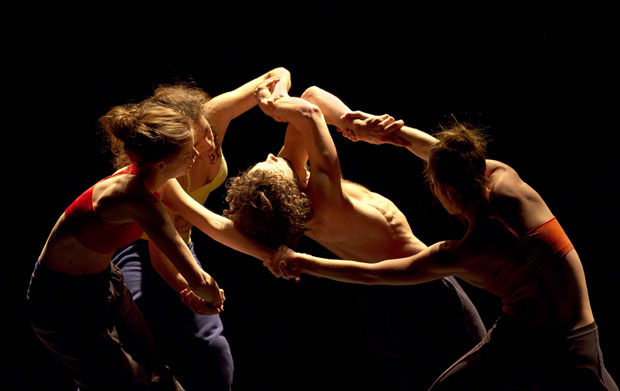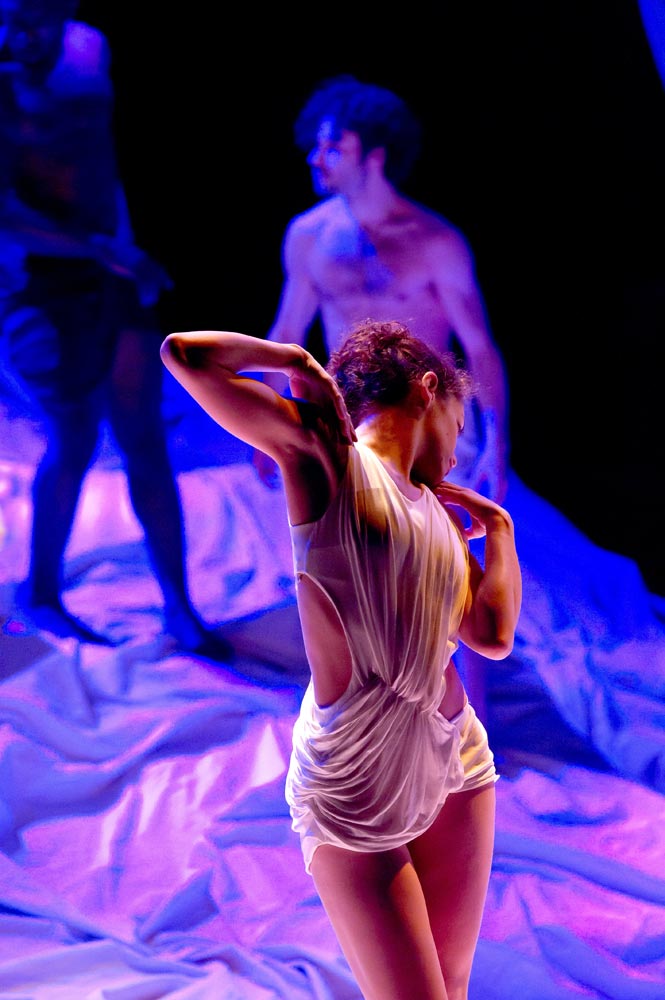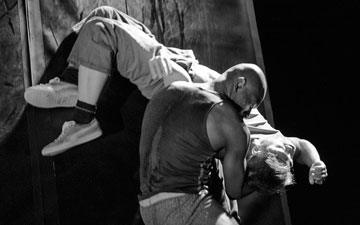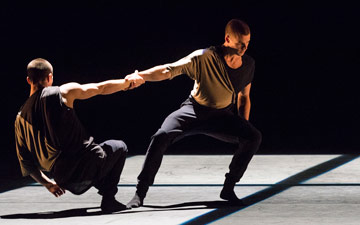
© Laurent Phillipe. (Click image for larger version)
Sculpted in Clay
Russell Maliphant
The Rodin Project
New York, Joyce Theater
6 December 2012
www.rmcompany.co.uk
www.joyce.org
The sculptor of Balzac, The Kiss, and The Burghers of Calais preferred to sketch his models in clay as they moved freely about his studio, thus forestalling the elegant inertia of academic statuary. He was also drawn to street performers, acrobats, and dancers, whose expressive bodies he captured in rough-hewn carvings full of tension and inner drama. In some cases, like his sketches of Isadora Duncan and her students, he surrendered to the natural grace of his classically-inspired models.
One can see why a choreographer might be drawn to Rodin, who hewed dancers from clay and bronze, creating the illusion of movement. Why not infuse these figures with life and set them in motion? The English choreographer, Russell Maliphant, seems fascinated by the idea of animating visual art – Nijinsky’s circular drawings were the subject of his recent Afterlife. But it’s easy to see the pitfalls of such a venture, and though Maliphant’s Rodin Project avoids some of them, it cannot dodge them all. On the positive side, the audience is spared the cliché of seeing overly-familiar sculptures like The Thinker recreated on the stage. Maliphant moves his dancers through certain allusive poses, but never freezes them in such a way that makes one cry, “aha! There it is!” for which we can be grateful. But in the process of exploring the torque and heightened three-dimensionality of Rodin, the choreographer has forgotten that dance also needs a purpose beyond its own display. Maliphant’s phrases – built from loping, crouching, gliding, or capoeira-like movement, sprinkled with break-dance pops – scroll in and out of themselves like purposeless curlicues of smoke, enhanced by impressionistic lighting. Which is not to say there are no intriguing moments, such as a slow-motion push-and-pull wrestling match in the first section that engages with its power and grace, and a vertical pas de deux set against a wall in which the choreographed movement seems to defy laws of gravity. Even lovelier is a sequence in which the three women, mostly nude but artfully draped in lengths of white cloth, show off their sinuous curves, turning and twisting languidly as if posing for a sculptor. Their bodies are undeniably beautiful, but at the same time the display feels both objectifying and old-fashioned: “Ah! Woman and her glorious curves!”

© Laurent Phillipe. (Click image for larger version)
Essentially, the work stagnates, lacking any driving force except the admiration of the human form and the dancers’ admirable muscular control. The Rodin Project is a study in plastique pure and simple, an exploration of forms. By objectifying the dancers and enveloping them in fabric and chiaroscuro light, it saps them of expressive depth, precisely the thing that makes Rodin’s sculpture so very interesting. If Rodin pulls expressivity out of bronze, Maliphant does the opposite: he turns his dancers into lumps of muscle and sinuous expanses of skin. More than sculpture, the choreography reminded me of exhibitions of body-building.

© Laurent Phillipe. (Click image for larger version)
As often happens in high-concept ventures built around a theme or image, there is no real sense of time. The inertia is exacerbated by Michael Hulls’ moody, mannered lighting, which lingers on every muscle and fold of the dancers’ garments. The unimaginative score (by Alexander Zekke) alternates between jabbing chords (drama!) and winding melodies for cello (meditation). As in a movie, the music tries to tell us what we’re meant to feel moment by moment. Slow, contemplative solos alternate with faster ensembles of rolling, lifting, interlocking bodies. The set is a multi-leveled structure (by Es Devlin, Bronia Housman, and Maliphant) with various tilted facets that the dancers use for sliding and climbing; it is probably the most imaginative element of the show. In a dark gap between two walls, the dancers materialize and disappear, creating an effect more mysterious than any of the dancing. Maliphant’s dancers are game and give their all, toiling in the anonymity of Hull’s dappled lighting, though the men’s hyper-developed muscles – especially on their backs and shoulders – give them a hunched-over posture that robs them of their natural grace. In any case, Maliphant has added nothing to our understanding of Rodin, nor has be in any way matched the power and monumentality of that sculptor’s figures.

















[…] This week the Joyce was presenting Russell Maliphant’s Rodin Project, a meditation on the torque and muscular power of Rodin’s sculptures. You can see the review here. […]
Everything is kept on the music. Choreography course talentless, but the article is even worse
Morty